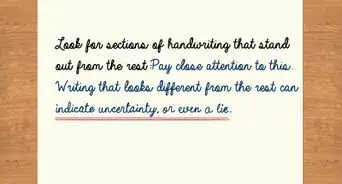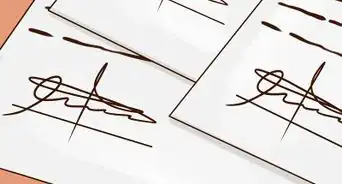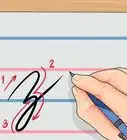wikiHow is a “wiki,” similar to Wikipedia, which means that many of our articles are co-written by multiple authors. To create this article, 340 people, some anonymous, worked to edit and improve it over time.
This article has been viewed 4,967,629 times.
Learn more...
Need advice on how to design your own signature? Whether you want your signature style to be ornate or minimalist, we're here to help you choose one that perfectly expresses your personality. Read on for our complete guide to creating a signature.
Steps
Analyzing Your Signature
-
1Read over your current signature. Ask yourself what you like about your current style, and what needs work. Look at the letters that make up your name and think about how you can best emphasize them: note the interesting letters (with a lot of loops, dots, and crosses, like G, X, or B) and the plain letters (especially those that look similar between uppercase and lowercase, like S or O). Look for any areas that could become focal points of your signature or even combining letters to make your signature smaller.
-
2Consider what you want your signature to say about you. A simple and clear signature will be easier for people to read, but a more complex signature might show more flair. The more flourish you put into your signature, the more flamboyant you may seem. Consider how your signature might speak to the luxury of time. Busy doctors often scrawl hasty, illegible signatures, whereas famous writers often take the time to orchestrate intricate designs.[1]
- Signatures that include just your initials (with or without the middle initial) are usually considered more formal and businesslike than full-name signatures.
- If you’re worried about forgery, consider making your signature longer and more legible. Include your entire first and last name. Be sure to write clearly. It is easier to forge scribbled signatures than it is to copy the nuances of a practiced, legible signature.
Advertisement -
3Think about which parts of your name you want to include. Some people sign their full name, and some sign only their first or last name. Some just use their initials. If you are known only by your first or last name—like Beyonce or Ronaldo— then you might consider using just the first name. If you are a professor who typically goes by their last name, you may just sign your surname.
-
4Draw inspiration from other signatures. Look at the signatures of famous people, and consider whether you want to emulate anybody. Kurt Vonnegut, Walt Disney, Salvador Dalí, Picasso, and John Hancock (among many others) are all known for their unique signature styles. Don't be afraid to borrow eye-catching elements and add them to your own signature.[2]
Reworking Your Signature
-
1Experiment. Rewrite your signature over and over to explore the possibilities. Have fun with it. Play with a variety of styles and flourishes. See what feels comfortable to write, looks good with your name, and isn’t too hard to copy repeatedly. Use a writing tool that feels right in your hand. Consider using pencil if you want to erase and rework your signature.
-
2Emphasize certain letters. Make a letter larger so that it stands out, or make it very small so that it blends in. This can give your signature a bold look without slowing your signing time down to a crawl. Try exaggerating the first letter of your name, or the first letters of your first and last name.[3]
- If your signature is messy or curly, you can emphasize one letter by making it sharp and clear. Likewise, make a single letter sloppy or fancy if you want it to stand out from an otherwise clean-cut signature.
-
3Underline your signature for emphasis. This is a classic way to make your name look more ornate. Underlining can also take more time to write out than a simpler style – so consider whether it's worth it.
- Turn one of your letters into an underline. This is commonly done with the last letter, but feel free to add a flourish to any letter that lends itself to the style. Letters with a long tail (y, g, j) are perfect. Drag the tail out beneath the signature.
- Underline your signature with loops. This is a very fluid, ornate way to spice up a signature.[4]
- Underline your signature with zigzags. These are similar to loops, but spikier and more angular.
-
4Use "old-timey" lettering. Double up on your horizontal crosses, and end your looped letters in hooks and flourishes. Use a fountain pen, if possible. Draw inspiration from calligraphy, from old signatures, and from Gothic lettering. This adds flair to even a simple signature.
-
5Add flourishes to spice up your signature. This can be a great way to make your style more unique. Look for letters that lend themselves to an exciting twist, and experiment with ways to make them look fancier. Try the following ideas:
- Use repeating elements. The three large ovals in this signature create an echo effect and help tie the whole design together.
- Allow your capital letters to encircle the lowercase letters. This is a useful way to spice up a name that doesn’t have any lower loops (g, j, etc.) to play with.
- Encircle the signature with loops. This creates a very regal, official-looking signature.
- Enlarge the bottoms of your letters. This is one of the simplest and most common ways to spruce up a signature.
-
6Add numbers or symbols to your signature. The symbols might include a team jersey number, a simple sketch, or a graduation year. If you associate a specific number or symbol with your identity (for instance, if you are well-known for your role on a sports team), this may be a good way to publicly distinguish yourself from people with similar names. If you want to go this route, it’s best to keep the rest of your signature straightforward to save time. Too many symbols can overwhelm the design and make for a long signing process.
Choosing Your Signature
-
1Combine your favorite elements into one signature. Find pieces of signatures that you like. Consider what works, what doesn't, and what suits your personality. As you practice your signature, tweak small details and flourishes until you've come up with something that feels right.
-
2Know when it feels right. Don't pick a signature only because it looks cool. Choose a signature that is stylistic, but also practical.
- Your signature should be easy to write and reproduce. It should feel good coming off of your hand, and it should be simple enough that you can dash it off in a matter of seconds.
- Your signature should suit your purpose and personality. If you want to show your dramatic side, use a signature with flair. If you want to tell people that you are neat and ordered, your signature should reflect that.
- Your signature should be identifiable. It shouldn't just look like a scribble on the page – unless it's a recognizable scribble, and it comes out like that every time. Make your signature unique so that people know it's yours.
-
3Practice your new signature until writing it feels natural. Remember that you can always change it, up to a point. If you use a certain signature on all of your legal documents (driver's license, passport, credit card, bank records) then it may be inconvenient to change it. In some cases, your signature actually serves to identify you, and you may arouse suspicion if you sign in a way that doesn't match the records.
-
4Make sure that you can easily replicate the new signature. The coolest, most complicated signature in the world is useless if you can't quickly sign it onto new documents. As you practice your signature, think about practicality: consider how fast you can sign it, whether you need any special writing tools, and whether you can make it look the same each time. If you can't easily reproduce your signature, you might want to simplify your design.
- Bear in mind that this does not apply to digital signatures. Most digital document-signing applications will save your personalized signature for later use. Sign it right once, and you can copy it to any future document. However. it may be wise to keep your digital signature consistent with your analog signature.
Community Q&A
-
QuestionDoes my signature have to be perfect or comfortable?
 Community AnswerIt is better for it to be comfortable. Don't worry no one is judging your signature since everyone's is different and very personal to one's own self.
Community AnswerIt is better for it to be comfortable. Don't worry no one is judging your signature since everyone's is different and very personal to one's own self. -
QuestionWhat if my handwriting is okay but I don't want to do a fancy signature?
 Community AnswerIt's simple––don't. Fancy signatures are a choice that some people feel is appropriate, while others couldn't care less. That said, it is much harder to forge a fancy signature, and this can make it useful. However, do what you're most comfortable with.
Community AnswerIt's simple––don't. Fancy signatures are a choice that some people feel is appropriate, while others couldn't care less. That said, it is much harder to forge a fancy signature, and this can make it useful. However, do what you're most comfortable with. -
QuestionHow can I get used to writing the signature so it looks the same each time?
 Community AnswerMinor differences each time are not a problem. Your signature will still be recognizable as long as the first letter is distinct, and you write letters with roughly the same motions (crossing t's with short or long strokes, making loops fat or thin). If you want a consistent signature, make it short and simple, and practice until it feels natural.
Community AnswerMinor differences each time are not a problem. Your signature will still be recognizable as long as the first letter is distinct, and you write letters with roughly the same motions (crossing t's with short or long strokes, making loops fat or thin). If you want a consistent signature, make it short and simple, and practice until it feels natural.
Warnings
- Keep your official signature fairly simple. Having to recreate an elaborate, time-consuming monstrosity every time you buy groceries will get old quickly.⧼thumbs_response⧽
- Think twice before going messy. Though it’s fun to stretch the limits of your signature style, carefully consider whether or not it’s practical for you to have an illegible one.⧼thumbs_response⧽
- Be careful with how often you change your signature. You may have a hard time proving your identity if the new signature doesn't match your ID, driver's license, your bank records, or even your library card.⧼thumbs_response⧽
References
- ↑ http://www.artofmanliness.com/trunk/1426/how-to-create-a-unique-and-manly-signature/
- ↑ http://designtaxi.com/news/366765/The-17-Coolest-Signatures-Of-Famous-People-Past-And-Present/
- ↑ http://www.writechoice.co.in/writechoice/index.php/2012/02/3-very-important-tips-to-improve-your-signature/
- ↑ http://www.financetwitter.com/2014/06/fifty-cool-signatures-of-worlds-rich-famous-people.html
About This Article
If you want to sign your name with a cool signature, try making certain letters larger so that they stick out or underlining your name for a classic style. You can also use elements of calligraphy, like loops and flourishes. If you’re an athlete, you could even add your number to your signature. Finally, combine your favorite elements into one signature, then practice signing it until it feels natural. For more tips, like drawing inspiration from other people's signatures that you think are cool, read on!



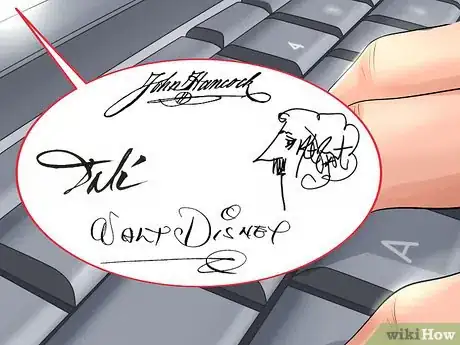
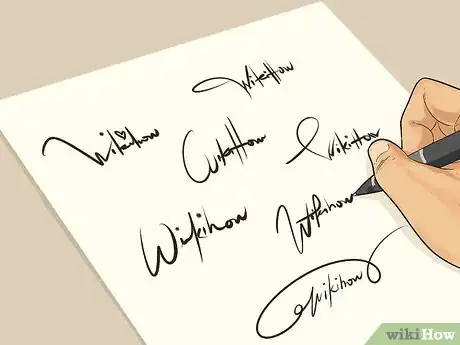
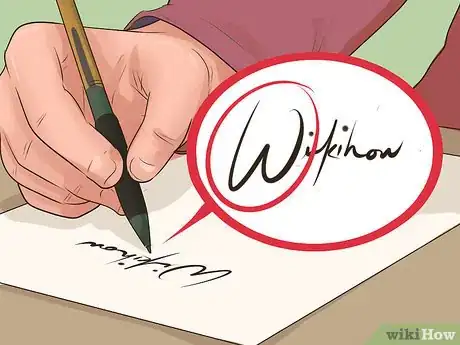
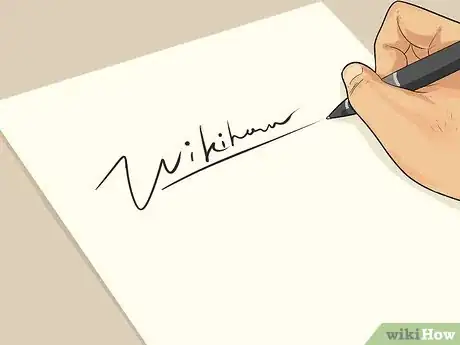
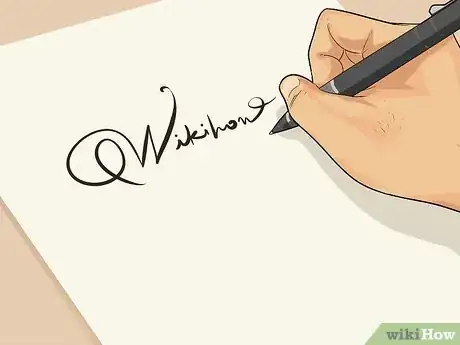

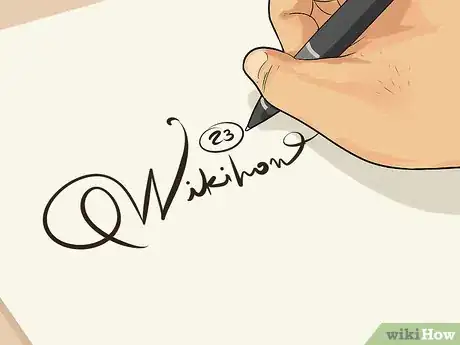
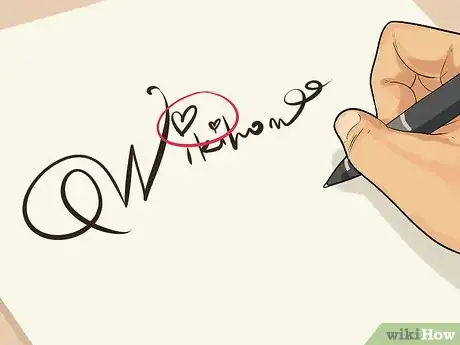
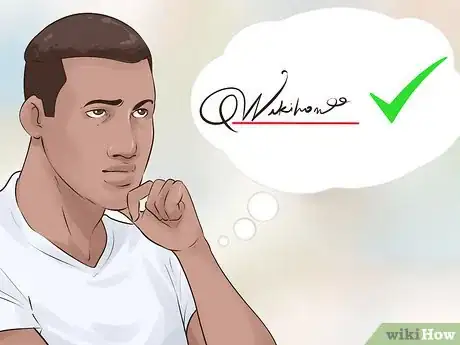





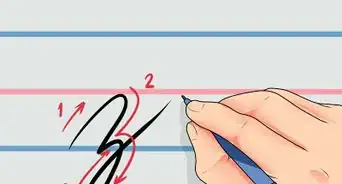
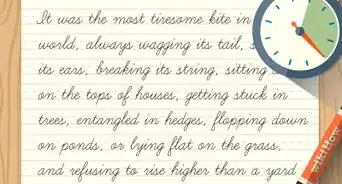
-Step-11-Version-3.webp)


